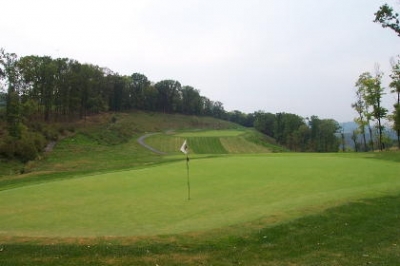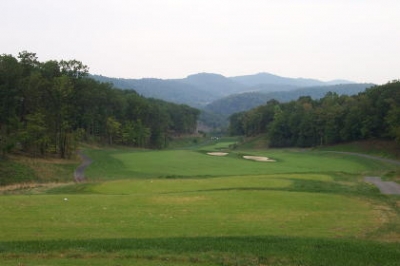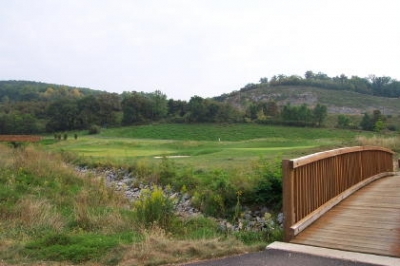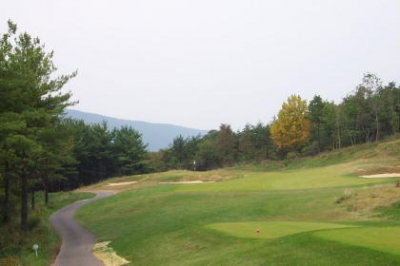By Jeffrey A. Rendall; Photos By Jeffrey A. Rendall
FLINTSTONE, MD -- It's amazing the difference, between the coastal regions of the Mid-Atlantic, and a couple hundred miles inland. Where the former is largely flat and sandy, the latter's rugged and mountainous.
There's also quite a difference in populations, with the hordes of humans preferring the ocean and the rugged mountain-types and critters opting for the high country. But despite the obvious differences in topography, there's great golf in both spots.
Western Virginia has the Homestead; West Virginia has the Greenbrier; and western Maryland now has Rocky Gap Lodge & Golf Resort, thanks to some forward thinking folks in the Maryland state government who thought it'd be a great place to build a high-end resort destination.
Rocky Gap Resort's Jack Nicklaus designed golf course (the only Nicklaus design in Maryland) opened in 1998, and the layout showcases the natural beauty the area is famous for. Though the resort's amenities and service are probably not on par with its aforementioned brethren in the states to the south, neither are the prices. Rocky Gap Resort is very family friendly, and overall, the presentation is very well done.
Dave Heatwole, Senior Design Associate of Nicklaus Course Designs and lead architect on the Rocky Gap project, says the demanding layout was also challenging to build: "I was very impressed with the ruggedness of the site when I first saw it, but I also knew it was going to be difficult to fit the golf course onto the mountainous section, which is now the front nine. But along with great challenge comes pretty great rewards, and we're really pleased with the way the course turned out."
 |
| Looking back at the 472 yard, par four 3rd hole, you'll understand why it's rated the most difficult on the course. |
As Heatwole alluded to, the front nine winds in, up and around hills and valleys. All in all, this course is quite a roller coaster ride, but well worth it because of the incredible scenery. In contrast, the back nine occupies much flatter ground (for the most part), offering different kinds of shot values and better scoring opportunities.
Heatwole said the project was unique for more than just the terrain: "It was the first project we'd ever built for a state owned entity, being part of a state park (Rocky Gap State Park). It was an interesting experience working with the various state agencies involved. In that respect, I think folks get a pretty solid golf product for the prices they charge, and we're proud of that."
That's true. For the quality of the layout and the general condition of the course, it's a tremendous value. There are also some attractive packages available.
Heatwole says the type of resort course it eventually became factored into the planning of the layout: "We knew Rocky Gap was going to be a resort course with a lot of first-time players, so we made the layout visibly exciting, but also designed it so there weren't any hidden hazards. The course 'reads' real well."
"Jack's courses tend to be fairly generous off the tees, with fairly broad landing areas. He doesn't like to take the driver out of your hands very often. And if you look at Rocky Gap, there's not a lot of fairway bunkering, and it requires a little bit more precision with your second shots into the greens," Heatwole said.
Part of the precision required for approach shots is due to the way Nicklaus positions the greens. Heatwole explains: "Jack likes to angle the greens so you're not just playing straight into the putting surfaces that much. That way you're either working the ball left or right, or over a bunker. It ensures that we're able to create a lot of variety in the course, so the resort player will want to come back and play. You're not going to be satisfied with playing it just one time."
John Johnson, Rocky Gap's Head Golf Professional, echoes Heatwole's assessment of the course: "Nicklaus really did a great job with the five sets of tees on our course. From the back sets, it's quite a tough test, but the less advanced golfers will find the front boxes a lot friendlier. The front nine is just outstanding, winding through the mountains. The back nine is more open, so you're rewarded for good shots. On the front, you're playing a lot more target oriented golf, just trying to survive."
 |
| The tee box view from the 'signature' par five 5th hole. Grip it n' rip it on this hole, because you'll have to gear down on the holes to come. |
It seems you'll get just as many survival tests playing Rocky Gap's front nine as you would in a week's worth of Boy Scout forays into the surrounding mountains. But it's just as fun, too.
Johnson puts it succinctly: "Definitely the number one thing when playing our course is keeping it in the fairway. You can hit a great shot, right down the fairway - and once it hits the surface you've got to keep an eye on it, because you can get some tricky bounces. Our rough's not that bad, but you certainly don't want to get in the Crown Vetch."
Crown Vetch?
If you don't know what it is prior to coming here, you'll certainly become acquainted before you leave. Heatwole (who said the 'stuff' is actually called Bird's-foot Trefoil) said it's the same type of plants growing on the sides of highways, and helps contain erosion. Because Rocky Gap has some difficult terrain, this thick vegetation was vital to help maintain the integrity of the hillsides.
But it's also a golf ball storage facility if you hit it in there. The gentleman behind our group called it 'Alligator Grass,' because if it goes in there, it isn't coming out.
All is not 'lost,' however. Johnson says they're gradually cutting it back to provide larger landing areas. That's good news, because it makes the layout's somewhat narrow driving avenues (on some holes) even more difficult to hit.
If you do manage to land safely in the fairways, you'll need to think your way into the best way to attack the greens. And on the uphill holes, you might have to contend with some nasty swales in the putting surfaces.
 |
| You'll have to take a bridge to reach the par three 16th green. And your ball will have to fly over trouble to get there, too. |
Heatwole says the tiers in the greens weren't meant to be punitive: "One of the reasons Jack put some large elevation changes in the greens was to give them visual definition from the fairway. On the uphill holes, he wants you to be able to see whether the pin is up or back, depending on if it's located on the upper or lower level. We didn't have the space to angle the green, so we decided to put the tiers in to show players where they needed to place the shot."
"Again, talking about philosophy, Jack wants you to be able to think as you're playing, and not just hit a shot to a green and not know what's there, or what you're hitting into. At least with the elevation changes, it gives you a much better idea of where the pin placement is," Heatwole said.
Another interesting aspect of Rocky Gap's golf course is the hole sequencing on the back nine. There are three par threes, three par fours and three par fives. Again, Heatwole said it was Nicklaus' personal work: "One of the changes Jack made during his visits was to reconfigure the back nine. Originally, we had two par fours set for holes 14 and 15, but Jack thought that was forcing things a bit, considering that stretch of ground is fairly narrow - so we made it a five and a three. Sixteen's also a three, so you've got back-to-back par threes."
Looking at the course, highlights include number five. Johnson says if they had just one 'signature' hole, that'd be it: "It's a downhill par five, reachable in two if you get off the tee well. You've just got those views of the mountains, and a terrific golf hole to play. It doesn't get much better."
Three's also quite a beautiful test: "Three is the number one handicap hole. Your drive has to be accurate in the fairway, with hazards to the right and left of the fairway. Then, you're left with a mid to high iron into the green. You'd better be careful on your alignment, because the fairway actually aims you down towards our driving range, which is right of the green. If you're not aware of where your body is pointing, your second shot will give you trouble," Johnson added.
On the back, the second par five is the thirteenth hole. Johnson said it's the only hole on the course with a sixth tee box, at the personal directive of Mr. Nicklaus. "Jack came in and looked over the hole and said he wanted a tee box right there beside the twelfth green on top of the hill. He was looking on top of the hill to the left hand side and said "I want a tee right there," so we built one."
Eighteen's a challenging close to the round. It's 428 yards in length, with one of the widest driving areas of the course - but the challenge is on the mid-iron approach shot. Johnson said if the pin's in back, take an extra club to reach the top level, or the ball's likely to roll all the way back down to the bottom. And judging from personal experience, you don't want to be in the front bunkers, either.
 |
| It doesn't get much easier going into the 206 yard, uphill par three 17th. Hit it high, land it soft. |
For the non-golfers in the group, there're plenty of outdoor activities to take part in, including: an indoor/outdoor pool and whirlpool; fitness room; tennis; 243 acre Lake Habeeb with boat rentals; beach volleyball; history tours; bike rentals, family evening programs, nature hikes and much more. The resort also offers conference and banquet facilities.
You won't go hungry, either. The Lakeside restaurant caters to your finer dining needs, featuring regional and national favorites. It's also where you'll find Sunday Brunch and a Friday night Seafood Buffet. The Lakeside Lounge is adjacent to the restaurant, offering lighter fare (recommended for the kids), and a relaxing atmosphere. Last but not least, there's the Signatures Bar & Grill, which offers casual dining, a relaxed atmosphere and weekend happy hours. It's definitely a good place to go for a cool one after your round.
Finally, one of the most attractive attributes of Rocky Gap Resort is its accessibility. It's an easy two-hour drive from the Washington DC and Baltimore metropolitan areas (all interstate highway, too - no windy two-lane mountain roads).
Putting it all together, Rocky Gap Resort provides a great chance to get away from the populous regions to the east, and offers a rock solid alternative to the beach.
Details:
Rocky Gap Lodge & Golf Resort
16701 Lakeview Rd, NE
Flintstone, MD 21530
Phone: (800) 724-0828; (301) 784-8500
FAX: (301) 784-8408
Website: www.rockygapresort.com
Course Designer: Jack Nicklaus
Nicklaus' Lead Architect: Dave Heatwole
Head Golf Professional: John Johnson
|
Tees |
Yardage/Slope |
|
Black |
7002/141 |
|
Blue |
6563/139 |
|
White |
6135/132 |
|
Gold |
5782/124 |
|
Red |
5198/123 |
Rates:
$65 for 18 holes; $34 for nine. Twilight Rates: Mon-Thurs, $40 (after 3:00 p.m.).
Rates include cart with GPS system. Range balls extra. Call for seasonal rates, and contact the resort for additional package pricing information.
| Related Links | Comments on this article? | |
|
Maryland National Golf Club Hollow Creek Golf Club Rocky Gap Resort PB Dye Golf Club in Ijamsville Whiskey Creek Golf Club |
E-mail Jeff Rendall, Editor: jrendall@golftheunitedstates.com |











